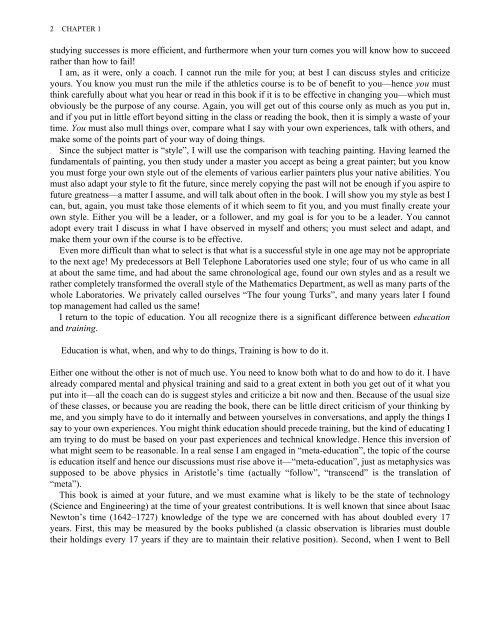hamming
hamming
hamming
You also want an ePaper? Increase the reach of your titles
YUMPU automatically turns print PDFs into web optimized ePapers that Google loves.
2 CHAPTER 1studying successes is more efficient, and furthermore when your turn comes you will know how to succeedrather than how to fail!I am, as it were, only a coach. I cannot run the mile for you; at best I can discuss styles and criticizeyours. You know you must run the mile if the athletics course is to be of benefit to you—hence you mustthink carefully about what you hear or read in this book if it is to be effective in changing you—which mustobviously be the purpose of any course. Again, you will get out of this course only as much as you put in,and if you put in little effort beyond sitting in the class or reading the book, then it is simply a waste of yourtime. You must also mull things over, compare what I say with your own experiences, talk with others, andmake some of the points part of your way of doing things.Since the subject matter is “style”, I will use the comparison with teaching painting. Having learned thefundamentals of painting, you then study under a master you accept as being a great painter; but you knowyou must forge your own style out of the elements of various earlier painters plus your native abilities. Youmust also adapt your style to fit the future, since merely copying the past will not be enough if you aspire tofuture greatness—a matter I assume, and will talk about often in the book. I will show you my style as best Ican, but, again, you must take those elements of it which seem to fit you, and you must finally create yourown style. Either you will be a leader, or a follower, and my goal is for you to be a leader. You cannotadopt every trait I discuss in what I have observed in myself and others; you must select and adapt, andmake them your own if the course is to be effective.Even more difficult than what to select is that what is a successful style in one age may not be appropriateto the next age! My predecessors at Bell Telephone Laboratories used one style; four of us who came in allat about the same time, and had about the same chronological age, found our own styles and as a result werather completely transformed the overall style of the Mathematics Department, as well as many parts of thewhole Laboratories. We privately called ourselves “The four young Turks”, and many years later I foundtop management had called us the same!I return to the topic of education. You all recognize there is a significant difference between educationand training.Education is what, when, and why to do things, Training is how to do it.Either one without the other is not of much use. You need to know both what to do and how to do it. I havealready compared mental and physical training and said to a great extent in both you get out of it what youput into it—all the coach can do is suggest styles and criticize a bit now and then. Because of the usual sizeof these classes, or because you are reading the book, there can be little direct criticism of your thinking byme, and you simply have to do it internally and between yourselves in conversations, and apply the things Isay to your own experiences. You might think education should precede training, but the kind of educating Iam trying to do must be based on your past experiences and technical knowledge. Hence this inversion ofwhat might seem to be reasonable. In a real sense I am engaged in “meta-education”, the topic of the courseis education itself and hence our discussions must rise above it—“meta-education”, just as metaphysics wassupposed to be above physics in Aristotle’s time (actually “follow”, “transcend” is the translation of“meta”).This book is aimed at your future, and we must examine what is likely to be the state of technology(Science and Engineering) at the time of your greatest contributions. It is well known that since about IsaacNewton’s time (1642–1727) knowledge of the type we are concerned with has about doubled every 17years. First, this may be measured by the books published (a classic observation is libraries must doubletheir holdings every 17 years if they are to maintain their relative position). Second, when I went to Bell


